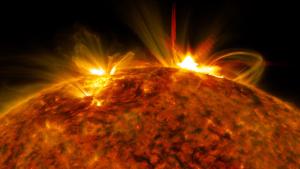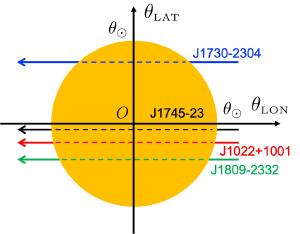Blog
Through and Through
27 April 2023
 NASA/SFC/SDO
NASA/SFC/SDOGravitational wave astronomy is still in its early stages. So far it has focused on the most energetic and distinct sources of gravitational waves, such as the cataclysmic mergers of black holes and neutron stars. But that will change as our gravitational telescopes improve, and it will allow astronomers to explore the universe in ways previously impossible.
Although gravitational waves have many similarities to light waves, one distinct difference is that most objects are transparent to gravitational waves. Light can be absorbed, scattered, and blocked by matter, but gravitational waves mostly just pass through matter. They can be lensed by the mass of an object, but not fully blocked. This means that gravitational waves could be used as a tool to peer inside astronomical bodies, similar to the way X-rays or MRIs allow us to see inside a human’s body.
This is the idea behind a recent study looking at how gravitational waves could be used to probe the Sun’s interior.1 The Sun is so incredibly hot and dense that light can’t penetrate it. Even light produced in the Sun’s core takes more than 100,000 years to reach the Sun’s surface. Our only information about the Sun’s interior comes from helioseismology, where astronomers study vibrations of the Sun’s surface caused by sound waves within the Sun.
In this new study, the team looks at how the gravitational waves of fast-rotating neutron stars could be used to study the Sun. Although a perfectly smooth rotating object doesn’t create gravitational waves, asymmetrical spinning objects do. Neutron stars can have deformations or mountainous rises caused by their interior heat or magnetic fields. If such a neutron star spins rapidly, it produces a continuous stream of gravitational waves. These gravitational waves are too faint to be observed by current telescopes, but the next generation of gravitational observatories should be able to detect them.
 Takahashi et al
Takahashi et alSince neutron stars are quite common in the galaxy, some of them are positioned such that the Sun passes in front of them from our perspective. Of the more than 3,000 known pulsars, about 500 of them are good candidates for gravitational wave sources, and of those 3 of them are known to pass behind the Sun. The team used the profiles of these three pulsars as a starting point.
Since the Sun is transparent to gravitational waves, the only effect the Sun has on them is through its gravitational mass. As the waves pass through the Sun, they are gravitationally lensed a bit. The amount of lensing depends on the mass of the Sun and the distribution of that mass. The team found that with proper measurements, gravitational wave observations could measure the density profile of the sun with an accuracy of 3σ.
The three known pulsars are likely just a tiny fraction of the gravitational wave sources that pass behind the Sun. Most neutron stars have a spin orientation that doesn’t direct radio flashes in our direction, but they could still be used as gravitational probes. There are likely hundreds of fast-rotating neutron stars that pass behind the Sun over the course of a year. So as we are able to observe their gravitational waves, they should give us an excellent view inside our closest star.
Ryuichi Takahashi, Soichiro Morisaki, and Teruaki Suyama. “Probing the solar interior with lensed gravitational waves from known pulsars.” arXiv preprint arXiv:2304.08220 (2023). ↩︎